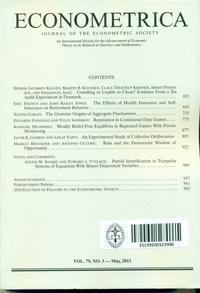Econometrica, Volume 87, Issue 3, p. 867-932
DOI: https://doi.org/10.3982/ECTA13693
An Equivalence Theorem between geometric structures and utility functions allows new methods for understanding preferences. Our classification of valuations into “Demand Types” incorporates existing definitions (substitutes, complements, “strong substitutes,” etc.) and permits new ones. Our Unimodularity Theorem generalizes previous results about when competitive equilibrium exists for any set of agents whose valuations are all of a “demand type.” Contrary to popular belief, equilibrium is guaranteed for more classes of purely‐complements than of purely‐substitutes, preferences. Our Intersection Count Theorem checks equilibrium existence for combinations of agents with specific valuations by counting the intersection points of geometric objects. Applications include matching and coalition‐formation, and the “Product‐Mix Auction” introduced by the Bank of England in response to the financial crisis.
VIEW PUBLICATION

Econometrica Front cover